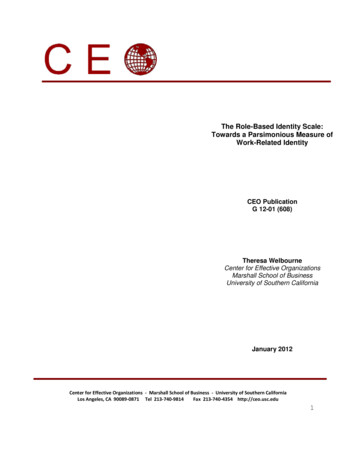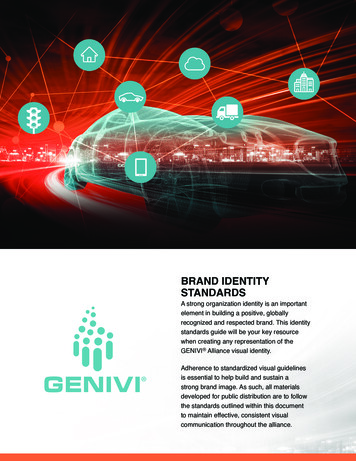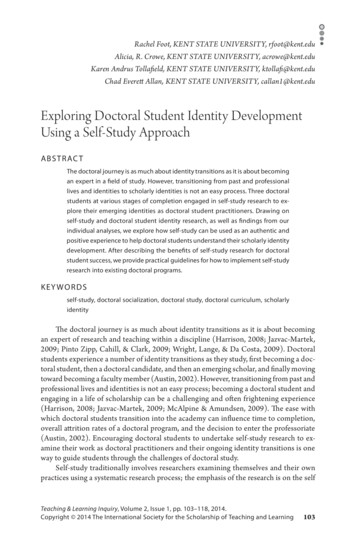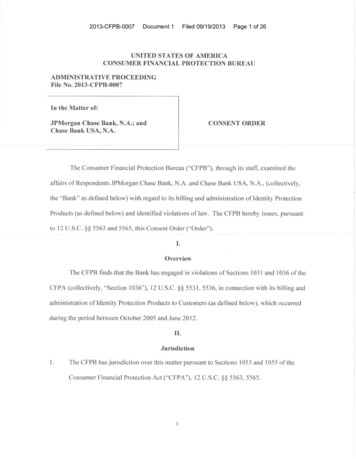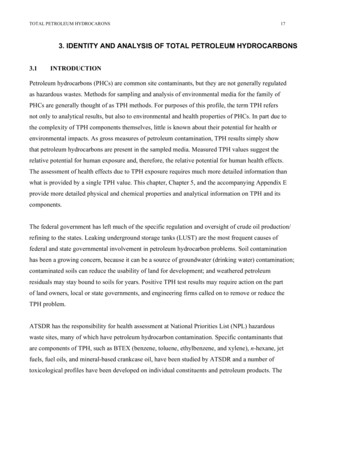
Transcription
TOTAL PETROLEUM HYDROCARONS173. IDENTITY AND ANALYSIS OF TOTAL PETROLEUM HYDROCARBONS3.1INTRODUCTIONPetroleum hydrocarbons (PHCs) are common site contaminants, but they are not generally regulatedas hazardous wastes. Methods for sampling and analysis of environmental media for the family ofPHCs are generally thought of as TPH methods. For purposes of this profile, the term TPH refersnot only to analytical results, but also to environmental and health properties of PHCs. In part due tothe complexity of TPH components themselves, little is known about their potential for health orenvironmental impacts. As gross measures of petroleum contamination, TPH results simply showthat petroleum hydrocarbons are present in the sampled media. Measured TPH values suggest therelative potential for human exposure and, therefore, the relative potential for human health effects.The assessment of health effects due to TPH exposure requires much more detailed information thanwhat is provided by a single TPH value. This chapter, Chapter 5, and the accompanying Appendix Eprovide more detailed physical and chemical properties and analytical information on TPH and itscomponents.The federal government has left much of the specific regulation and oversight of crude oil production/refining to the states. Leaking underground storage tanks (LUST) are the most frequent causes offederal and state governmental involvement in petroleum hydrocarbon problems. Soil contaminationhas been a growing concern, because it can be a source of groundwater (drinking water) contamination;contaminated soils can reduce the usability of land for development; and weathered petroleumresiduals may stay bound to soils for years. Positive TPH test results may require action on the partof land owners, local or state governments, and engineering firms called on to remove or reduce theTPH problem.ATSDR has the responsibility for health assessment at National Priorities List (NPL) hazardouswaste sites, many of which have petroleum hydrocarbon contamination. Specific contaminants thatare components of TPH, such as BTEX (benzene, toluene, ethylbenzene, and xylene), n-hexane, jetfuels, fuel oils, and mineral-based crankcase oil, have been studied by ATSDR and a number oftoxicological profiles have been developed on individual constituents and petroleum products. The
TOTAL PETROLEUM HYDROCARONS183. IDENTITY AND ANALYSIS OF TOTAL PETROLEUM HYDROCARBONSATSDR profiles relevant to petroleum products are listed in Table 3- 1. However, TPH itself has notbeen as extensively studied by ATSDR and no previous profile was developed. Although severaltoxicological profiles have been developed for petroleum products and for specific chemicals found inpetroleum, TPH test results have been too nonspecific to be of real value in the assessment of itspotential health effects.Several approaches are discussed in this document for interpreting TPH and related analytical results.The TPH approach taken by EPA and others, through the mid-1990s, followed general riskassessment approaches for chemical mixtures. In all approaches there is a need to reduce acomprehensive list of potential petroleum hydrocarbons to a manageable size. Depending on howconservative the approach is, methods that have been used select: (1) the most toxic among the TPHcompounds (indicator approach); (2) one or more representative compounds (surrogate approach, butindependent of relative mix of compounds); or (3) representative compounds for fractions of similarpetroleum hydrocarbons. ATSDR has taken, in part, the third approach in keeping with the TotalPetroleum Hydrocarbons Criteria Working Group (TPHCWG), but has developed its own set of TPHfraction representatives, many of which overlap those of the TPHCWG. In addition, this profileprovides information on petroleum products, where such information exists. TPH risk (screening)values for fractions presented in this profile are based on the ATSDR MRLs previously developed forindividual constituents and petroleum products. These MRLs are summarized in Appendix A. Thisfraction approach is the most demanding in information gathering and because of that would appearto be the most rigorous approach to date. Sections 6.1.2 and 6.1.3 contain a more comprehensivediscussion of the approaches. The identity, chemical-physical, and analytical information discussedand listed in this chapter, in Appendices D and E, and in Chapter 5 are integral to defining TPH.3.2CHEMICAL AND PHYSICAL INFORMATIONPetroleum products are complex mixtures of hundreds of hydrocarbon compounds, ranging from light,volatile, short-chained organic compounds to heavy, long-chained, branched compounds. The exactcomposition of petroleum products varies depending upon (1) the source of the crude oil (crude oil isderived from underground reservoirs which vary greatly in their chemical composition) and (2) therefining practices used to produce the product.
TOTAL PETROLEUM HYDROCARONS203. IDENTITY AND ANALYSIS OF TOTAL PETROLEUM HYDROCARBONSDuring the refining process, crude oil is separated into fractions having similar boiling points. Thesefractions are then modified by cracking, condensation, polymerization, and alkylation processes, andare formulated into commercial products such as naphtha, gasoline, jet fuel, and fuel oils. Thecomposition of any one of these products can vary based on the refinery involved, time of year,variation in additives or modifiers, and other factors. The chemical composition of the product can befurther affected by weathering and/or biological modification upon release to the environment. Thefollowing subsections present overviews of petroleum products. Also, a master list of individualaliphatic and aromatic compounds found in TPH is provided in Appendix D. Further information onwhole petroleum products, their identity, major components, and physical/chemical properties isfound in Appendix E.Automotive Gasoline. Automotive gasoline is a mixture of low-boiling hydrocarbon compoundssuitable for use in spark-ignited internal combustion engines and having an octane rating of at least60. Additives that have been used in gasoline include alkyl tertiary butyl ethers (e.g. MTBE), ethanol(ethyl alcohol), methanol (methyl alcohol), tetramethyl-lead, tetraethyl-lead, ethylene dichloride, andethylene dibromide.Other categories of compounds that may be added to gasoline include anti-knock agents, antioxidants,metal deactivators, lead scavengers, anti-rust agents, anti-icing agents, upper-cylinderlubricants, detergents, and dyes (ATSDR 1995a).Automotive gasoline typically contains about 150 hydrocarbon compounds, though nearly 1,000 havebeen identified (ATSDR 1995a). The relative concentrations of the compounds vary considerablydepending on the source of crude oil, refinery process, and product specifications. Typical hydrocarbonchain lengths range from C4 through Cl2 with a general hydrocarbon distribution consisting of4-8% alkanes, 2-5% alkenes, 25-40% isoalkanes, 3-7% cycloalkanes, l-4% cycloalkenes, and20-50% aromatics (IARC 1989a). However, these proportions vary greatly. Unleaded gasolinesmay have higher proportions of aromatic hydrocarbons than leaded gasolines.Table E-1.b (Appendix E) presents ranges and weight percentage means for a representative subset ofthe hydrocarbon compounds identified in gasoline. In cases where data are not available, the rangeand mean are left blank.
TOTAL PETROLEUM HYDROCARONS213. IDENTITY AND ANALYSIS OF TOTAL PETROLEUM HYDROCARBONSStoddard Solvent. Stoddard solvent is a petroleum distillate widely used as a dry cleaning solventand as a general cleaner and degreaser. It may also be used as a paint thinner, as a solvent in some typesof photocopier toners, in some types of printing inks, and in some adhesives. Stoddard solvent isconsidered to be a form of mineral spirits, white spirits, and naphtha; however, not all forms of mineralspirits, white spirits, and naphtha are considered to be Stoddard solvent (ATSDR 1995b).Stoddard solvent consists of 30-50% linear and branched alkanes, 30-40% cycloalkanes, and lo-20%aromatic hydrocarbons. Its typical hydrocarbon chain ranges from C7 through C12 in length.Although a complete list of the individual compounds comprising Stoddard solvent is not available (AirForce 1989) some of the major components are presented in Table E-2.b (Appendix E). Alcohols,glycols, and ketones are not included in the composition, as few, if any, of these types of compoundswould be expected to be present in Stoddard solvent (ATSDR 1995b). Possible contaminants mayinclude lead ( 1 ppm) and sulfur (3.5 ppm).Jet Fuel. Jet fuels are light petroleum distillates that are available in several forms suitable for use invarious types ofjet engines. The exact compositions of jet fuels are established by the U.S. Air Force,using specifications that yield maximum performance by the aircraft. The major jet fuels used by themilitary are JP-4, JP-5, JP-6, JP-7, and JP-8. Briefly, JP-4 is a wide-cut fuel developed for broadavailability in times of need. JP-6 is a higher cut than JP-4 and is characterized by fewer impurities. JP-5is specially blended kerosene, and JP-7 is a high flash point special kerosene used in advanced supersonicaircraft. JP-8 is a kerosene modeled on Jet A-l fuel (used in civilian aircraft). For this profile, JP-4 willbe used as the prototype jet fuel due to its broad availability and extensive use.Typical hydrocarbon chain lengths characterizing JP-4 range from C4 to C16. Aviation fuels consistprimarily of straight and branched alkanes and cycloalkanes. Aromatic hydrocarbons are limited to20-25% of the total mixture because they produce smoke when burned. A maximum of5% alkenes areallowed in JP-4 (ATSDR 1995c). The approximate distribution by chemical class is: 32% straightalkanes, 31% branched alkanes, 16% cycloalkanes, and 21% aromatic hydrocarbons (ABBEnvironmental 1990). The typical hydrocarbon composition of JP-4 is presented in Table E-3.b(Appendix E).
TOTAL PETROLEUM HYDROCARONS223. IDENTITY AND ANALYSIS OF TOTAL PETROLEUM HYDROCARBONSFuel Oil #1. Fuel oil #l is a petroleum distillate that is one of the most widely used of the fuel oiltypes. It is used in atomizing burners that spray fuel into a combustion chamber where the tiny dropletsbum while in suspension. It is also used as a carrier for pesticides, as a weed killer, as a mold releaseagent in the ceramic and pottery industry, and in the cleaning industry. It is found in asphalt coatings,enamels, paints, thinners, and varnishes.Fuel oil #1 is a light petroleum distillate (straight-run kerosene) consisting primarily of hydrocarbons in therange C9-C16 (ATSDR 19958). Fuel oil #l is very similar in composition to diesel fuel oil #l; the primarydifference is in the additives. The typical hydrocarbon composition of fuel oil #l is presented inTable E-4.b (Appendix E).Fuel Oil #2. Fuel oil #2 is a petroleum distillate that may be referred to as domestic or industrial. Thedomestic fuel oil #2 is usually lighter and straight-run refined; it is used primarily for home heating and toproduce diesel fuel #2. Industrial distillate is the cracked type, or a blend of both. It is used in smeltingfurnaces, ceramic kilns, and packaged boilers (ABB Environmental 1990).Fuel oil #2 is characterized by hydrocarbon chain lengths in the C11-C20 range, whereas diesel fuelspredominantly contain a mixture of C10-C19 hydrocarbons (ATSDR 1995g). The composition consists ofapproximately 64% aliphatic hydrocarbons (straight chain alkanes and cycloalkanes), l-2% unsaturatedhydrocarbons (alkenes), and 35% aromatic hydrocarbons (including alkylbenzenes and 2-, 3-ringaromatics) (Air Force 1989). Fuel oil #2 contains less than 5% polycyclic aromatic hydrocarbons (IARC1989b). The typical hydrocarbon composition of fuel oil #2 is presented in Table E-4.b (Appendix E).Fuel Oil #6. Fuel oil #6 is also called Bunker C or residual. It is the residual from crude oil after thelight oils, gasoline, naphtha, fuel oil #l, and fuel oil #2 have been fractioned off. Fuel oil #6 can beblended directly to heavy fuel oil or made into asphalt. It is limited to commercial and industrial useswhere sufficient heat is available to fluidize the oil for pumping and combustion (ABB Environmental1990).Residual fuel oils are generally more complex in composition and impurities than distillate fuels. Limiteddata are available on the composition of fuel oil #6 (ATSDR 1995g). Clark et al. (1990) indicate that fueloil #6 includes about 25% aromatics, 15% paraffins, 45% naphthenes, and 15% non-hydrocarbon
TOTAL PETROLEUM HYDROCARONS233. IDENTITY AND ANALYSIS OF TOTAL PETROLEUM HYDROCARBONScompounds. Polycyclic aromatic hydrocarbons (PAHs) and alkyl PAHs and metals are importanthazardous and persistent components of fuel oil #6. Table E-4.b (Appendix E) presents the results of ananalysis of one sample (Pancirov and Brown 1975).Mineral Oils, Including Mineral-based Crankcase Oil. Mineral oils are often lubricating oils,but they also have medicinal and food uses. A major type of hydraulic fluid is the mineral oil class ofhydraulic fluids (ATSDR 1997b). The mineral-based oils are produced from heavy-end crude oildistillates. Distillate streams may be treated in several ways, such as vacuum-, solvent-, acid-, or hydro- treated, toproduce oils with commercial properties. Hydrocarbon numbers ranging from C15 to C50 arefound in the various types of mineral oils, with the heavier distillates having higher percentages of thehigher carbon number compounds (IARC 1984).Crankcase oil or motor oil may be either mineral-based or synthetic. The mineral-based oils are morewidely used than the synthetic oils and may be used in automotive engines, railroad and truck dieselengines, marine equipment, jet and other aircraft engines, and most small 2- and 4-stroke engines.The mineral-based oils contain hundreds to thousands of hydrocarbon compounds, including a substantialfraction of nitrogen- and sulfur-containing compounds. The hydrocarbons are mainly mixtures of straightand branched chain hydrocarbons (alkanes), cycloalkanes, and aromatic hydrocarbons. PAHs, alkylPAHs, and metals are important components of motor oils and crankcase oils, with the used oils typicallyhaving higher concentrations than the new unused oils. Typical carbon number chain lengths range fromCl5 to C50 (ABB Environmental 1990).Because of the wide range of uses and the potential for close contact with the engine to alter oilcomposition, the exact composition of crankcase oil/motor oil has not been specifically defined. Table E5.b (Appendix E) presents analytical results for some constituents in used automotive oil (ABBEnvironmental 1990).
TOTAL PETROLEUM HYDROCARONS243. IDENTITY AND ANALYSIS OF TOTAL PETROLEUM HYDROCARBONS3.3ANALYTICAL METHODSThe purpose of this section is to describe well established analytical methods that are available fordetecting, and/or measuring, and/or monitoring TPH and its metabolites, as well as other biomarkersof exposure and effect of TPH. The intent is not to provide an exhaustive list of analytical methods.Rather, the intention is to identify well-established methods that are used as the standard methodsapproved by federal agencies and organizations such as EPA and the National Institute forOccupational Safety and Health (NIOSH) or methods prescribed by state governments for water andsoil analysis. Other methods presented are those that are approved by groups such as ASTM.The term “total petroleum hydrocarbons” (TPH) is generally used to describe the measurable amountof petroleum-based hydrocarbons in the environment; and thus the TPH information obtained dependson the analytical method used. One of the difficulties with TPH analysis is that the scope of themethods varies greatly. Some methods are nonspecific while others provide results for hydrocarbonsin a boiling point range. Interpretation of analytical results requires an understanding of how thedetermination was made.Analytical methods for some petroleum products are discussed in existing ATSDR toxicologicalprofiles. The very volatile gases (compounds with 4 carbons or less), crude oil, and the solidbituminous materials such as asphalt are not included in this discussion of analytical methods.ATSDR profiles relevant to petroleum products are listed in Table 3-1. The TPHCWG alsoaddresses some of these issues from a different perspective which includes, in some cases, more detailand references than provided here (TPHCWG 1998a).3.3.1Environmental Samples.Most of the analytical methods discussed here for TPH have been developed within the framework offederal and state regulatory initiatives. The initial implementation of the Federal Water PollutionControl Act (FWPCA) focused on controlling conventional pollutants such as oil and grease. Methodsdeveloped for monitoring wastewaters included EPA Method 4 13.1 (EPA 1979a) and EPA Method413.2 (EPA 1979d) for Total Recoverable Oil and Grease (TOG), and EPA Method 418.1 for TotalRecoverable Petroleum Hydrocarbons (TRPH) (EPA 1979c). Freon-extractable material is reportedas TOG. Polar components may be removed by treatment with silica gel, and the material remaining,
TOTAL PETROLEUM HYDROCARONS253. IDENTITY AND ANALYSIS OF TOTAL PETROLEUM HYDROCARBONSas determined by infrared (IR) spectrometry, is defined as Total Recoverable Petroleum Hydrocarbons(TPH, TRPH, or TPH-IR). A number of modifications of these methods exist. EPA Method 418.1has been one of the most widely used methods for the determination of TPH in soils. Many states use,or permit the use of, EPA Method 418.1 for identification of petroleum products and duringremediation of sites (George 1992; Judge et al. 1997, 1998). This method is subject to limitations,such as inter-laboratory variations and inherent inaccuracies (George 1992). In addition, the EPAproposed to withdraw wastewater methods which use Freon- 113 extraction (EPA 1996a). Thesemethods will be replaced with EPA Method 1664: n-Hexane Extractable Material (HEM) and Silica GelTreated n-Hexane Extractable Material (SGT-HEM) by Extraction and Gravimetry (Oil and Greaseand Total Petroleum Hydrocarbons) (EPA 1996a). Conventional methods of TPH analysis aresummarized in Table 3-2.These conventional TPH analytical methods have been used widely to investigate sites that may becontaminated with petroleum hydrocarbon products. Many state and local regulatory agencies rely onand require EPA Method 418.1 (EPA 1979c) for determination of petroleum hydrocarbons (Murray1994). The important advantages of this approach are (1) the method is relatively inexpensive, and(2) excellent sample reproducibility can be obtained. The disadvantages are (1) petroleumhydrocarbon composition varies among sources and over time, so results are not always comparable;(2) the more volatile compounds in gasoline and light fuel oil may be lost in the solvent concentrationstep; (3) there are inherent inaccuracies in the method; and (4) the method provides virtually noinformation on the types of hydrocarbons present. Several recent reports have detailed the problemswith this approach (George 1992; Rhodes et al. 1995/1996). Thus, these conventional TPH methods,although they provide adequate screening information, do not provide sufficient information on theextent of the contamination and product type. In addition, The Clean Air Act Amendments of 1990require the phaseout of the use of chlorofluorocarbons. Therefore, the EPA methods using Freon-l 13will be replaced with EPA Method 1664, n-Hexane Extractable Material (HEM) and Silica GelTreated n-Hexane Extractable Material (SGT-HEM) by Extraction and Gravimetry (EPA 1996a).Proposed Method 1664 includes thorough method quality control, but results may not equivalent tothe current methods. Examples of TPH methods for environmental media are shown in Table 3-3.Gas chromatography (GC) methods do provide some information about the product type. Mostmethods involve a sample preparation procedure followed by analysis using GC techniques. GC
TOTAL PETROLEUM HYDROCARONS303. IDENTITY AND ANALYSIS OF TOTAL PETROLEUM HYDROCARBONSdetermination is based on selected components or the sum of all components detected within a givenrange. Frequently the approach is to use two methods, one for the volatile range and another for thesemivolatile range. Volatiles in water or solid samples are determined by purge-and-trap GC/FID.The analysis is often called the gasolines range organics (GRO) method. The semivolatile range isdetermined by analysis of an extract by GC/FID and is referred to as diesel range organics (DRO).Individual states have adopted methods for measuring GRO and DRO contamination in soil andwater. The specific method details and requirements vary from state to state. Some of the GC TPHmethods are summarized in Table 3-4.In the mid-1980s underground storage tank (UST) programs were a focus of federal and stateinitiatives. The criteria and methodology for determining contamination are generally state-specific.Although many states still use EPA Method 418.1, GC procedures have been developed to providemore specific information on hydrocarbon content of waters and soils (Judge et al. 1997, 1998).GRO and DRO are specified in some cases, and several states, such as California and Wisconsin,aggressively developed programs to address groundwater contamination problems. These GCmethods, coupled with specific extraction techniques, can provide information on product type bycomparison of the chromatogram with standards. Quantitative estimates may be made for a boilingrange or for a range of carbon numbers by summing peaks within a specific window. Although thesemethods provide more product information than the TPH and TOG methods, they are not withoutlimitations. These include high results caused by interferences, low recovery due to the standardselected, petroleum product changes caused by volatility, and microbial activity (Restek 1994).Many methods are available for analysis of petroleum hydrocarbon products, particularly in waterand soil matrices. The current literature includes a number of studies that document the performanceand limitations of the commonly used methods. Method modifications and new methods are beinginvestigated to provide better information about the petroleum component content of environmentalsamples. However, the available analytical methodology alone may not provide adequate informationfor those who evaluate the movement of petroleum components in the environment or evaluate thehealth risks posed to humans (Heath et al. 1993a).In its work to develop a fraction approach to assess TPH risks the TPH Criteria Working Group(TPHCWG) has developed an analytical method for identifying and quantifying the presence of the
TOTAL PETROLEUM HYDROCARONS323. IDENTITY AND ANALYSIS OF TOTAL PETROLEUM HYDROCARBONSgroups or fractions with similar mobility in soils. The technique is based on EPA Method 3611(Alumina Column Cleanup and Separation of Petroleum Wastes) and EPA Method 3630 (Silica GelCleanup), which are used to fractionate the hydrocarbon into aliphatic and aromatic fractions. A gaschromatograph equipped with a boiling point column (non-polar capillary column) is used to analyzewhole soil samples as well as the aliphatic and aromatic fractions to resolve and quantify thefate-and-transport fractions selected by the TPHCWG (Gustafson 1997). The method is versatile andperformance-based and, therefore, can be modified to accommodate data quality objectives(Gustafson 1997).The Massachusetts Department of Environmental Protection (MADEP) approached its needs toevaluate the potential health effects of petroleum hydrocarbons similarly by defining analyticalfractions. MADEP’s method is based on standard EPA Methods (8020/8015 Modified), which allowsit to be easily implemented by contract laboratories (Gustafson 1997; Hutcheson et al. 1996). Lighterhydrocarbon fractions (C6-C12 are analyzed by purge-and-trap GC analysis using a FID to measurethe total hydrocarbons and a photoionization detector (PID) to measure the aromatics. The aliphatic(e.g., hexane) component of the TPH is found by determining the difference. Aromatic and aliphaticfractions are divided into carbon number fractions based on the normal alkanes (e.g., n-octane) asmarkers. Heavier hydrocarbons (C12-C26) are analyzed using an extraction procedure followed by acolumn separation using silica gel (Modified EPA Method 3630) of the aromatic and aliphaticgroupings or fractions. The two fractions are then analyzed using GC/FID. PAH markers andn-alkane markers are used to divide the heavier aromatic and aliphatic fractions by carbon number,respectively. A couple of concerns about the methodology have been expressed: (1) the PID is notcompletely selective for aromatics and can lead to an overestimate of the more mobile and toxicaromatic content; and (2) the results from the two analyses, purgeable and extractable hydrocarbons,can overlap in carbon number and cannot be simply added together to get a total TPH concentration.Few methods are available for monitoring petroleum products in other matrices such as plant andanimal tissue and food.
TOTAL PETROLEUM HYDROCARONS333. IDENTITY AND ANALYSIS OF TOTAL PETROLEUM HYDROCARBONS3.3.1.1 Soils and SedimentsMethods for determining TPH in soils and sediments are discussed in Section 3.3.1 above. Thesemethods are used primarily for UST programs. Currently, many of the states have adopted EPA Method418.1 or modified EPA Method 801.5 or similar methods for analysis during remediation of contaminatedsites. Thus, there is no standard for TPH analysis; each state has adopted its own criteria, and in somecases, developed its own methodologies (Murray 1994).There is a trend toward use of GC techniques in analysis of soils and sediments. One aspect of thesemethods is that “volatiles” and “semivolatiles” are determined separately. The volatile or GROcomponents are recovered using purge-and-trap or other stripping techniques (Chang et al. 1992; EPA1995d; McDonald et al. 1984). Semivolatiles are separated from the solid matrix by solvent extraction(EPA 1995d). Other extraction techniques have been developed to reduce the hazards and the cost ofsolvent use and to automate the process (Gere et al. 1993). Techniques include supercritical fluidextraction (SFE) (Fitzpatrick and Tan 1993; Gere et al. 1993; Hawthorne et al. 1993; Lopez-Avila et al.1993) microwave extraction (Hasty and Revesz 1995; Lopez-Avila et al. 1994) Soxhlet extraction(Martin 1992) sonication extraction (Martin 1992) and solid phase extraction (SPE) (Schrynemeeckers1993). Capillary column techniques have largely replaced the use of packed columns for analysis, as theyprovide resolution of a greater number of hydrocarbon compounds.3.3.1.2 Water and Waste WaterMethods for determining TPH in aqueous samples are discussed above in Section 3.3.1. The overallmethod includes sample collection and storage, extraction, and analysis steps. Sampling strategy is animportant step in the overall process. Care must be taken to assure that the samples collected arerepresentative of the environmental medium and that they are collected without contamination. There arenumerous modifications of the EPA, American Public Health Association (APHA), and AmericanSociety for Testing and Materials (ASTM) methods discussed above. Most involve alternate extractionmethods developed to improve overall method performance for TPH or replacement of thechlorofluorocarbon solvents. SPE techniques have been applied to water samples (Schrynemeeckers1993). Solvent extraction methods with hexane (Murray and Lockhart 1981; Picer and Picer 1993) ormethylene chloride (Mushrush et al. 1994) have been reported as well.
TOTAL PETROLEUM HYDROCARONS343. IDENTITY AND ANALYSIS OF TOTAL PETROLEUM HYDROCARBONS3.3.1.3 AirMethods for determining hydrocarbons in air matrices usually depend upon adsorption of TPHcomponents onto a solid sorbent, subsequent desorption and determination by GC techniques.Hydrocarbons within a specific boiling range (n-pentane through n-octane) in occupational air arecollected on a sorbent tube, desorbed with solvent, and determined using GC/FID (NIOSH 1994).Although method precision and accuracy are good, performance is reduced at high humidity.Compounds in the boiling range 80-200 ºC in ambient air may be captured on a Tenax GC adsorbenttube which is thermally desorbed for GC/MS analysis (EPA 1988). Performance of the method hadnot been established on a compound-by-compound basis (EPA 1988). Gasoline vapor in air may besampled on a tube containing Tenax adsorbent. The traps are thermally desorbed and analyzed byGC/FID. The minimum detectable concentration is 0.03 mg/m3 total hydrocarbons in a 2.5 L sample.Excellent recovery was reported ( 90%) (CONCAWE 1986). Passive adsorbent monitors (badges)may also be used. Compounds are solvent-desorbed from the exposed adsorbent and analyzed by GC.Good recovery ( 80%) has been reported for target n-alkanes and for gasoline, naphtha, and Stoddardsolvent (3M 1993).The Massachusetts Department of Environmental Protection (MADEP), along with ENRS, Inc., ofActon, Massachusetts, has developed a method for taking and analyzing air samples for the presenceof petroleum hydrocarbons (MADEP 1999). This Air-phase Petroleum Hydrocarbon (APH) methoduses SUMMA canisters and GC/MS for sampling and analysis of ambient air, indoor air, and soilgas. This method can be downloaded from the MADEP website (http://www.state.ma.us/dep). Thecomplex mixture of petroleum hydrocarbons potentially present in an air sample is separated intoaliphatic and aromatic fractions, and then these two major fractions are separated into smallerfractions based on carbon number. Individual compounds (e.g., benzene, toluene, ethylbenzene,xylenes, MTBE, naphthalene) are also identified u
conservative the approach is, methods that have been used select: (1) the most toxic among the TPH compounds (indicator approach); (2) one or more representative compounds (surrogate approach, but independent of relative mix of compounds); or (3) representative c
